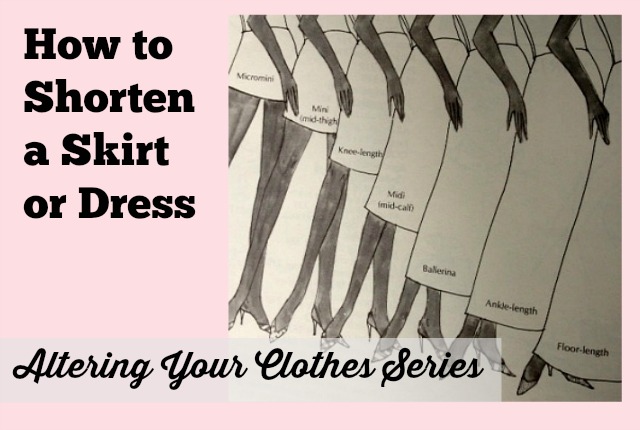
Where your dress or skirt falls on your legs impacts your overall look. Even just a couple inches longer or shorter can change the entire an outfit from off to great. Since most of us benefit from a longer looking leg it’s handy to know how to shorten your skirt or dress. There are two ways. You can stick to one way or you can vary it up depending on the garment and your schedule.
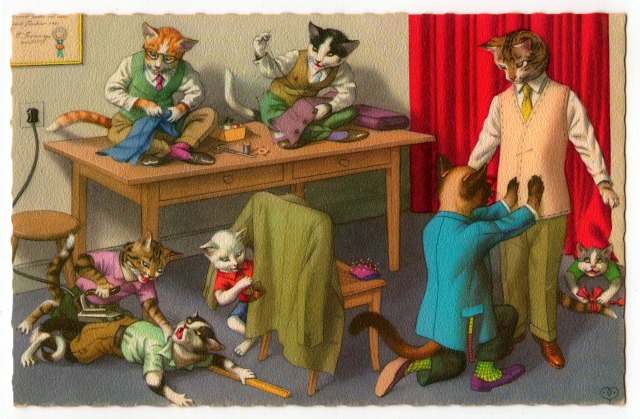
First way: take your skirt or dress to a tailor. They can help you decide what length is best on you and then, with their magic skills, will hem it. (If it’s a skirt, wear the top or type of top you think you will wear with that skirt and wear it how you think you will wear it, tucked, not tucked.)
From here you can then repeat this new length at home when you shorten other skirts or dresses that are too long. OR if you love their work and the cost was not too dear, take your other skirts and dresses to them to shorten.
Just because you can sew doesn’t always mean it’s the best option. Sometimes your life is busy or it’s a complicated hem or difficult fabric and you don’t want to mess with it. It’s much better to take the garment to a professional and pay for them to hem it than for the item to stay in your closet or mending pile, not being worn, because you don’t have the time or inclination to hem it. Go get it hemmed and enjoy wearing it. That’s why you bought it, right?
Second way: Shorten the skirt or dress yourself. It’s not hard to do.
Put the skirt on and stand in front of a full length mirror. Hike the skirt up by turning the waist band over onto itself or raising the waistband and clamping any extra fabric with a clothes pin or chip clip in the back (so the skirt stays up). Adjust and readjust until you find that sweet spot. This will take some time but better to put the time here than re-hemming it because the first time you were off. (I’ve made that mistake)
If it’s a dress you are trying on raise the hem by grabbing on to the dress at the side seams. lift and lower to see. Clip the fabric up, near your waist with clothes pins or chip clips to hold the hem up. This lets you see the length with your hands at your sides and shoulders not raised due to holding the fabric up.

If you are unsure about any length you tried there are formulas to help you find your ideal skirt length. (I’ve included links below). This will give you a place to start but don’t skip trying on the skirt and raising it a little above and a little below “your ideal” length. Skirts are different, fabric weight, fullness and style will play a part in the “ideal” length for each skirt.
Here are three blog post that tell you their formula for finding your ideal skirt length:
And one with no formula but good tips: 40 plus Style
Now that you have an idea of what length you want to skirt or dress to be drop the extra fabric or unroll the waist band so the skirt or dress falls to it’s original length. Take note the difference between the original length and where you want it to end.
With the skirt still on, pin up this difference across the front or so. Double check in the mirror that yes, this is great. Adjust the pins if needed.
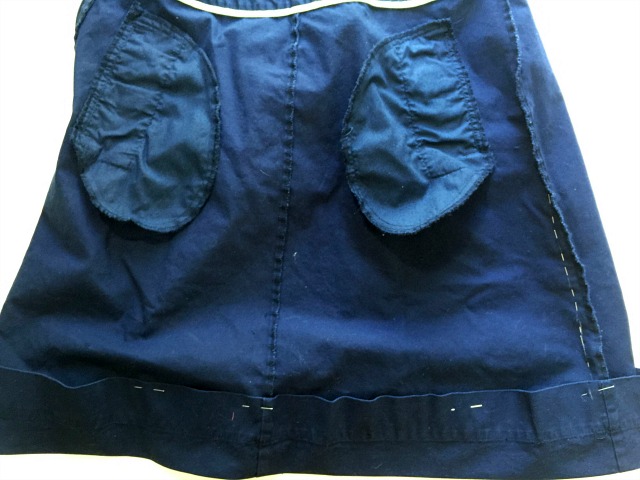
Take off the skrit or dress and measure how much you’ve pinned it up. Measure in a few spots to get the best idea. One pin might be holding up 5 inches and another pin holding up only 4.5 inches. Split the difference or go with the measurement you have pinned up the most. Skirt or dress off, measure the amount pinned up.
If you are shortening the skirt or dress above the original hem you can leave that hem in. If you are shortening just above the original hem you will need to take the original hem out in order to use the fabric caught in the original hem to turn under the new hem.
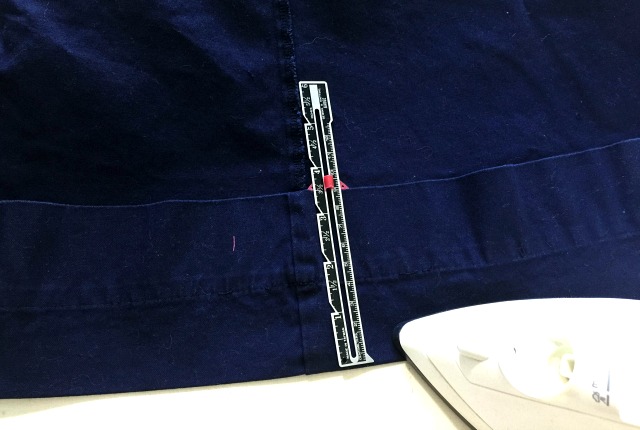
After deciding on a firm amount to raise the hem, measure up the amount, fold and press. Do this all the way around the skirt or dress.
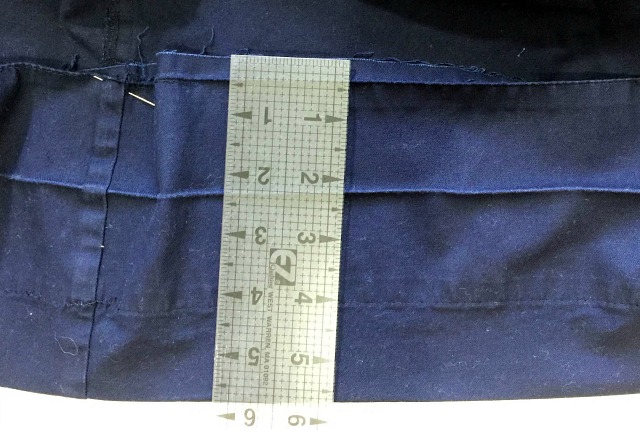
My original hem hem was 2 inches deep plus almost a 1/2 inch to turn under the raw edge. (I took the hem out of the skirt to alter the side seams as well). You do not have to copy the original hem depth or how the raw edge is finished. This is your decision.
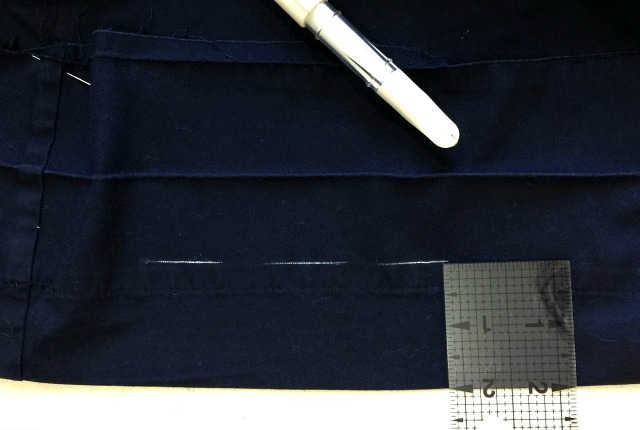 Measure up from the new bottom edge (the fold you pressed) and mark the amount you need for your new hem. I marked just the amount I need for the hem, not including any amount to turn under. Here’s why:
Measure up from the new bottom edge (the fold you pressed) and mark the amount you need for your new hem. I marked just the amount I need for the hem, not including any amount to turn under. Here’s why:
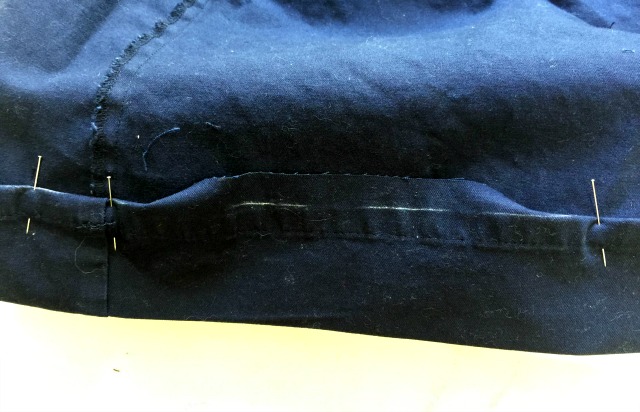
I cut about a half inch above my marked line. I visually estimate that the scissors are a half inch away from my line as I cut. My line shows me where I’m going to fold the raw edge under so what amount gets turned under does not have to be perfectly a half inch or what ever amount you are turning under. It should be roughly the same width, it just doesn’t have to be exact.
This saves you from measuring a second time. If you had made your cutting line to include the turn under you would now have to measure where to turn under.
Fold, press and pin in a few spots. Match the side seams in the hem allowance with the side seams on the skirt. Do this for any other seams as well. Ease in any fullness when necessary.
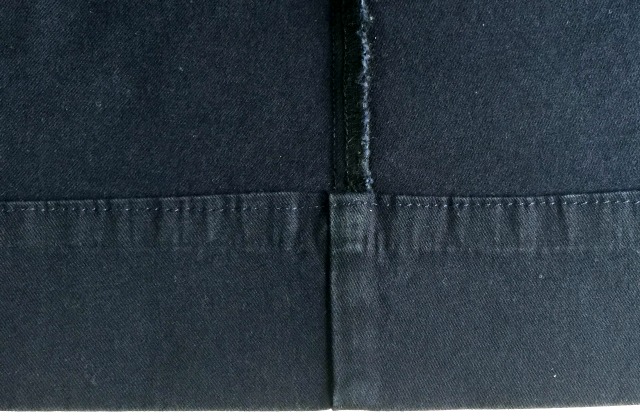
After the new hem is pressed up and pinned it’s just a matter of sewing it down in place.
Here’s a tip for making an accurate seam guide when your machine’s guides aren’t wide enough. Rule Your Machine: How to Make an Accurate Seam Guide
Press your stitching in the opposite direction you sewed to set the stitches and take out any waviness. If you have a small pucker on the outside where fullness was eased in, you can often, manipulate them out with steam, pressing and your fingers. (Check how much heat the fabric can handle)
 (My skirt has some stretch in the twill, so I didn’t really think about this when I sewed it. I used the wrong needle and the wrong tension so I have some waviness that the iron will not take out)
(My skirt has some stretch in the twill, so I didn’t really think about this when I sewed it. I used the wrong needle and the wrong tension so I have some waviness that the iron will not take out)
Alright, a skirt or dress that looks great on you. Now you will wear it more often and feel good wearing it. You look stylish because as we all know a great fit is the best style.

Thank you for stating that you should take your skirt or dress to a tailor because they can help you decide what length is best on you. My cousin’s wedding is coming up next month, and the length of the dress I got is too long, and I want to get it altered. I will definitely utilize all of your great tips and information when altering my dress.
A tailor has so much experience and can probably pinpoint exactly what alterations are needed in a minute. And although many folks who sew can do the alterations themselves, sometimes it’s worth hiring a good tailor and then spending all those hours you would have needed to do the alteration (because when you don’t do alterations often it takes a while to think it through), on sewing something fun.
Thanks for telling me that knowing how to sew isn’t always the best option for my dresses. I noticed that three out of five dresses that I ordered online don’t fit my waistline accurately. I initially thought of learning how to sew but as you have mentioned, it might be better to seek a professional that offers tailoring services instead.
It’s good to know when it’s worth your time and when to hire someone else 😉 Your comment made me smile, Thanks
Thanks for the great post! Darn this stuff seems so hard!
I’m glad you liked the post. The hardest part for me is starting – and then after that taking it slow enough to think about what I’m doing. Apparently, I have 2 speeds – still and fast 😉